
Early last week, a remarkable thing happened. Sikh children took to NYC streets again- some in strollers- and they were heard.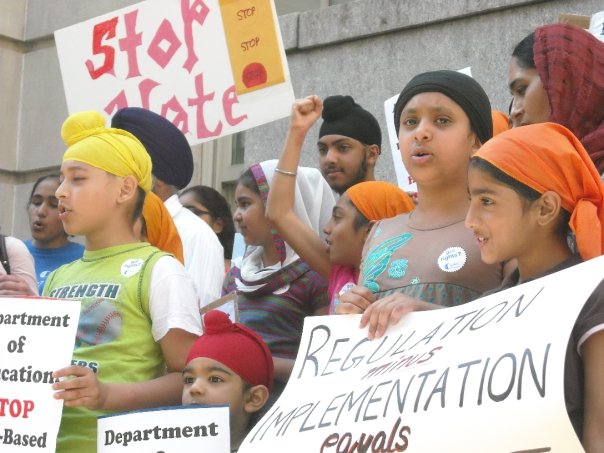
Last fall, the New York Department of Education passed a regulation in response to disturbing findings about the bullying that Sikh children face in schools. The regulation promised to define, track, and prevent bias-based harassment in NYC public schools. So after the first school year in which the regulation was in effect, how did the schools measure up?
The results were made public at a recent press conference by the Sikh Coalition and Sikh youth in NYC in front of the Department of Education’s headquarters. The Sikh Coalition teamed up with area organizations including the Coalition for Asian American Children and Families (CACF) and the Asian American Legal Defense and Education Fund (AALDEF), to release a report card grading the first year of the regulation’s implementation. Speakers at the press conference included representatives from Queens and Brooklyn schools and organizations such as the New York Civil Liberties Union (NYCLU), Desis Rising Up and Moving (DRUM), and Make the Road NY.
Problems remain, the report card shows. Based on the Sikh Coalition’s survey, there was no significant decline in the rate of harassment in the first year of the regulation’s implementation. [pg.9] Perhaps most disturbingly, out of all harassment reported by children, 16% was committed by a school official such as a teacher, school staff member, or security officer. [pg.12] In addition, after 90% of reported incidents of harassment to school officials, the school failed to properly follow protocol for investigation and follow-up. [pg.11]
For the full report card, click here.
 Things are heating up as Sikh transit workers organize against the MTA’s requirement that Sikh workers wear an MTA logo on their turbans. The rationale? The MTA’s position is that this policy is necessary for customers to identify their employees. However, neither the NY City Council, nor the U.S. Department of Justice, is buying this baloney. The 27 of the City Council’s 51 members recently voted to sign onto a letter to the MTA President, opposing the policy, and the Department of Justice has revived an employment discrimination case against the MTA.
Things are heating up as Sikh transit workers organize against the MTA’s requirement that Sikh workers wear an MTA logo on their turbans. The rationale? The MTA’s position is that this policy is necessary for customers to identify their employees. However, neither the NY City Council, nor the U.S. Department of Justice, is buying this baloney. The 27 of the City Council’s 51 members recently voted to sign onto a letter to the MTA President, opposing the policy, and the Department of Justice has revived an employment discrimination case against the MTA.
There are, of course, many ways that customers can identify MTA workers, from the badges they may wear, to a uniform vest, to a standard outfit. So why attempt to brand the turban, specifically? This policy shift, along with previous failed attempts, is indicative of the MTA’s general hostility to religious inclusion and work staff diversity.
Oh India. You can’t hide the skeletons in your closet forever.
It appears that the US Commission on International Religious Freedom was on its way to India this week. (The USCIRF is a federal group that works to promote freedom of thought, conscience and religion; protect people from abuses like detention, killing and torture; and challenge religious intolerance and repression throughout the world.) Well, they were scheduled to go, had their tickets ready and their bags packed. But India’s administration decided that they weren’t welcome in India.
It’s really quite ironic. The Congress party’s recent Parliamentary win over the BJP has been seen as an explicit rejection of the religious intolerance that the BJP represents (though it may have had more to do with support for Congress’ economic policies). Yet it is the Congress party administration that has refused USCIRF entry. Maybe the Congress party’s sound defeat of the BJP has swelled the Congress Party’s confidence a little too much.
New Delhi knew that the USCIRF team was scheduled to leave on June 12, but the visas just didn’t get stamped in time. Was it just a rare and regrettable oversight? [After all, with so many tourists flooding the country, a few visas could fall through the cracks right? (HA!)]
I wanted to take the time to highlight two issues (Part 2 to be posted soon) which have plagued the Punjabi Sikh community for many, many years. I know that discussing these issues over and over again is overwhelmingly tedious for the majority of people. Quite frankly, I agree. However, if I didn’t believe that having these important discussions and bringing awareness to these issues over (and over, and over) again added some value to potential solutions – then I wouldn’t waste the space. Needless to say, these issues don’t seem to be going away which means these conversations are that much more important to have.
A recent article in the NYTimes expresses surprise at the fact that female feticide is occurring within immigrant communities residing in the United States. The thought seems to be that preference of male children should ideally disappear with assimilation into western societies. (For those of us hanging out in The Langar Hall, we know this isn’t always the case in the Punjabi community). The article uses US Census Data to provide quantitative evidence that there exists a bias for male children in certain Asian American communities.
Demographers say the statistical deviation among Asian-American families is significant, and they believe it reflects not only a preference for male children, but a growing tendency for these families to embrace sex-selection techniques, like in vitro fertilization and sperm sorting, or abortion.
New immigrants typically transplant some of their customs and culture to the United States – from tastes in food and child-rearing practices to their emphasis on education and the elevated social and economic status of males. [emphasis added]
This latter point is especially significant. Is the problem of sex-selective abortions purely cultural and is that why it continues to be an “acceptable” problem?
 Just before the weekend, NPR featured a story on Akal Securities and the Sikh community in New Mexico. The article discusses the success of a number of businesses that help support the 3HO organization. It is partly due to these generous contributions by community members and leaders of these businesses that as a community we benefit from the inspiring resources such as Sikhnet.com. As an attendee at the annual Los Angeles Vaisakhi Nagar Kirtan, I have witnessed the beautiful display of the Sikh community, largely led by members of the 3HO, year after year.
Just before the weekend, NPR featured a story on Akal Securities and the Sikh community in New Mexico. The article discusses the success of a number of businesses that help support the 3HO organization. It is partly due to these generous contributions by community members and leaders of these businesses that as a community we benefit from the inspiring resources such as Sikhnet.com. As an attendee at the annual Los Angeles Vaisakhi Nagar Kirtan, I have witnessed the beautiful display of the Sikh community, largely led by members of the 3HO, year after year.
For those familiar with Akal Securities, you can find their ubiquitous khanda symbol everywhere. From airports, to security guards in front of Target, I have had a sense of pride whenever I see their logo. It is a tremendous example of our Sikh brethren being successful and specifically an example of individuals that use their success to contribute to the Sikh community in general. This is not to say that the company has not had its share of problems (and successes), but still I believe it is a model and a successful one and deserves recognition.
Ravi Singh Bhalla was elected to the City Council in Hoboken, New Jersey this past week! A city that is less than 1% Asian and predominately white, Hobokens elected Bhalla with 5,810 votes. Bhalla had the highest number of votes amongst the 6 candidates competing for the 3 council seats.
In an e-mail out to supporters, Ravi’s brother, Amardeep Singh, described the bigotry they received during this campaign. He writes:
“… elections are not always for the faint of heart … we were cursed at constantly, literature was ripped out of our hands and stomped on, I was told by someone “I love killing Arabs”, and I was asked whether I “had a green card.”
Despite these attacks, the residents of Hoboken voted for Bhalla because he was a committed candidate who focused on the issues. Bhalla says, “It’s very humbling … it shows that people were focused on what a candidate brought to the table.”
Mark your calendars- the Kaur Foundation and the Asian Division of the Library of Congress have 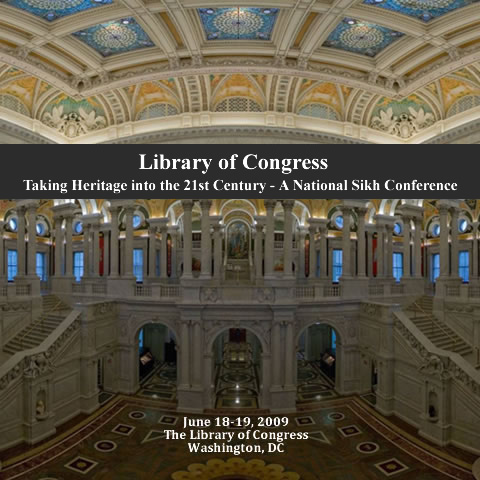 teamed up to undertake a unique initiative, to institutionalize knowledge by and about the Sikh community for future generations. The Library of Congress is the oldest federal cultural institution in the US, the largest library in the world, and the research wing of Congress. (LOC). The Sikh Collection Initiative is an effort to ensure that knowledge of and by Sikhs is collected and preserved for future generations. Given the tragic loss of valuable cultural and religious artifacts, manuscripts, and books from the Sikh Reference Library in the Darbar Sahib complex during Operation Bluestar, an initiative such as this begins to ensure that collective knowledge of our community will be preserved somewhere.
teamed up to undertake a unique initiative, to institutionalize knowledge by and about the Sikh community for future generations. The Library of Congress is the oldest federal cultural institution in the US, the largest library in the world, and the research wing of Congress. (LOC). The Sikh Collection Initiative is an effort to ensure that knowledge of and by Sikhs is collected and preserved for future generations. Given the tragic loss of valuable cultural and religious artifacts, manuscripts, and books from the Sikh Reference Library in the Darbar Sahib complex during Operation Bluestar, an initiative such as this begins to ensure that collective knowledge of our community will be preserved somewhere.
As our nation grows and becomes more diverse, it is critical that we appreciate and understand the different backgrounds of all that make this country great. Sikh Americans have significantly contributed to every field of human endeavor from technology, commerce, health, science, agriculture, to the arts – further enriching the cultural fabric of this land of immigrants.
 As talking heads buzzed with news of President Obama’s nomination of Sonia Sotomayor to the Supreme Court, there has also been a flurry of commentary. Is her selection tokenizing? Is it triumphant? Is she smart enough? Is she nice enough? I don’t think it’s particularly useful to parse the commentary on Judge Sotomayor specifically — a lot of the back and forth parallels and reproduces the tropes that come out in any discussion addressing privilege and remediation.
As talking heads buzzed with news of President Obama’s nomination of Sonia Sotomayor to the Supreme Court, there has also been a flurry of commentary. Is her selection tokenizing? Is it triumphant? Is she smart enough? Is she nice enough? I don’t think it’s particularly useful to parse the commentary on Judge Sotomayor specifically — a lot of the back and forth parallels and reproduces the tropes that come out in any discussion addressing privilege and remediation.
The same day, a relatively lengthy commentary previewed on NPR’s morning edition. It argued that while Obama’s nomination was a triumph (if successful, Sotomayor will be the first woman of color and first Latina on the Court), the President should examine other forms of diversity on the bench. Specifically, he should appoint an LGBT Justice, next.
This past weekend, as I was talking to a Punjabi Sikh woman who came to the United States about 13-14 years ago, I heard how agency and perseverance define the experiences of immigrant women in the United States. She told me about the great new apartment she just got for her family and how the laundry is free. A new apartment building with free laundry, that is absolutely awesome! Her smile, confidence, and enthusiasm were strongly lined with struggle and hard work; although she never directly said it. Her hard work and perseverance resounded clearly and loudly as it lay nestled in her comment about how her children had seen a lot of struggle in their lives. This statement meant that they had witnessed her struggle to provide the basic necessities in life, which means not always having access to the privileges other children gain more easily. I sensed her confidence in her and her family’s work ethic, but also her own guilt of not being able to provide more.
This month, New America Media (NAM) released the results of a historic poll on woman immigrants to America. Often the experiences of women immigrants are not fore grounded in immigration research. They and their children are general viewed as the “dependents” of the sojourner husband/father. Their struggle, as the one mentioned above, are rarely brought to the center of the immigrant narrative.
 At the Langar Hall, we’ve covered a number of Sikh candidates’ campaigns for local government office. I just wanted to include a brief update about Ravi Bhalla, who looks poised to become one of Hoboken’s first Sikh city councilmembers as he enters a run-off election next month:
At the Langar Hall, we’ve covered a number of Sikh candidates’ campaigns for local government office. I just wanted to include a brief update about Ravi Bhalla, who looks poised to become one of Hoboken’s first Sikh city councilmembers as he enters a run-off election next month:
While it is clear that Peter Cammarano and Dawn Zimmer will vie for the Hoboken mayoralty on June 9, the provisional ballots may still change the neck-and-neck race to see which of the last three of six council-at-large candidates get into the runoff on that date. […]
As of Tuesday night, it looked like the top six will be as follows:
[1.] Carol Marsh 3,719
[2.] Ravi Bhalla 3,698
[3.] Dave Mello 3,361 [link]
When we last covered this story, Ravi was running as an independent for office. Since then, he joined a “reform” slate and has been campaigning extensively. His success comes as a surprise to some, who don’t understand how a practicing Sikh could get so far…
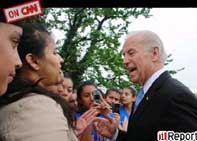
Gurbakhash Kaur Questioning Vice President Joe Biden
One of the major issues affecting the Sikh community is increasing civic engagement in the United States. We often focus on getting more Sikhs to vote and lobby our politicians about the issues affecting our community. This lobbying general pertains to writing letters and signing petitions that ask our community members to move beyond taking pictures with politicians at fundraising events or giving them awards at local melas. This past week, a young Sikh woman, Gurbakhash Kaur, highlighted what it means for a Sikh to be civically engaged. She questioned Vice President Biden “about two Sikhs in the United States Army who were told to cut their hair in order to serve” and Governor Jon Corzine about rising health education costs, while her Sikh peers stood by her side. These handshaking events were not a forum set-up for accountability, but more as photo-ops for the politicians. However, Gurbakhash Kaur was determined to make hand-shaking an opportunity to hold our elected officials accountable to their Sikh constituency.
As a resident of Lodi, New Jersey, she got face-time with Vice President Biden during his visit for a new construction project to widen Main Street and US Route 46. During her questioning, World Sikh News reports that:
Vice President Biden interrupted Kaur to tell her a member of his staff is a Sikh and did not allow her to finish her question. Afterwards, Kaur said, “I want the story to get coverage, as hardly anyone pays attention to our issues . . . we need a lot more legal support and begging and pleading to get our issues addressed.”
Ultimately, Gurbakhash Kaur’s actions are inspiring because she highlights an example of Sikh’s standing up for our rights through self-empowerment. More importantly, she acted through self-organizing rather than taking part in an event organized by other groups to mobilize the Sikh community.
Kuddos to Gurbakhash Kaur for demanding accountability from our elected officials!
Many students face physical and psychological bullying in schools- elementary, middle, and high. But Sikh students, male and female, often face especially severe bullying. Over the past couple years, some severe cases have come into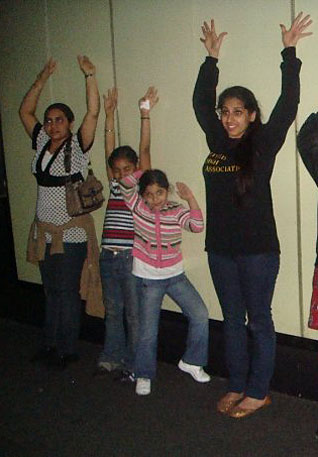 the public eye, including one teenager’s patka being set on fire, and others whose hair was forcibly cut. For statistics on the prevalence of harassment against Sikh students in New York schools, check out the Coalition’s report, “Hatred in the Hallways.”
the public eye, including one teenager’s patka being set on fire, and others whose hair was forcibly cut. For statistics on the prevalence of harassment against Sikh students in New York schools, check out the Coalition’s report, “Hatred in the Hallways.”
One pro-active student at Baruch College (of the City University of New York) has come up with a simple and creative way to provide support to kids facing harassment. Through his school’s Sikh Student Association, he started a mentoring program called Sikh Scouts. The students, aged 5-12 are paired with older Sikhs of the same gender, and go on a day’s outing together.
Sikh Scouts is essentially a small-scale Sikh youth mentoring event that aims to forge and develop a long-lasting relationship with children in need of good Sikh role models to help them guide them on the path of Sikhi. [link]
One of the students from Baruch that participated in the program wrote about the experience.
After they warmed up to us and broke through their initial shyness, the kids couldn’t stop talking about their favorite movies, TV shows and music – the Jonas Brothers and what not. And in between all of that, we got down to the serious issues: a majority of the kids did not enjoy school and felt uncomfortable because of harassment or teasing by their peers. [link]
There might not be much that anyone, including the older Sikh Scouts, can do to make the bullying stop- after all, kids will be kids. But what we older Sikh students can do for our younger counterparts is to be a source of strength, share insights about why it’s important to be comfortable with who you are whether it fits someone else’s definition of cool or not, and be there to offer advice for specific situations. There are things we’ve learned in hindsight that can benefit those facing the same harassment today.
 As someone who considers herself honorary Peruvian (it’s a long story) – I was especially proud when I heard about Operation Walk – an organization established by Harpal Singh Khanuja and his wife Maria Khanuja. The non-profit organization is dedicated to providing free knee and hip replacements to underserved people around the world. The concept behind the organization was to perform complicated surgeries on people in developing countries, “where arthritis progresses to its end stages and reconstructing joints becomes technically challenging.” Often times, it is people who are most at need who cannot afford the surgery. A news article discusses Operation Walk’s recent trip to Lima, Peru where they performed 48 surgeries to replace knee and hip joints. Here on TLH we like to highlight examples of seva – this is another important example of what it means to do selfless service,
As someone who considers herself honorary Peruvian (it’s a long story) – I was especially proud when I heard about Operation Walk – an organization established by Harpal Singh Khanuja and his wife Maria Khanuja. The non-profit organization is dedicated to providing free knee and hip replacements to underserved people around the world. The concept behind the organization was to perform complicated surgeries on people in developing countries, “where arthritis progresses to its end stages and reconstructing joints becomes technically challenging.” Often times, it is people who are most at need who cannot afford the surgery. A news article discusses Operation Walk’s recent trip to Lima, Peru where they performed 48 surgeries to replace knee and hip joints. Here on TLH we like to highlight examples of seva – this is another important example of what it means to do selfless service,
“It was very rewarding to do this work for people and not expecting anything in return,” Harpal Singh said. “It’s really their gratitude that you cherish the most.”
The organization’s goal is to replicate the Peru mission to Panjab where the need is also great (some of which can be attributed to the chemical farming of the Green Revolution).
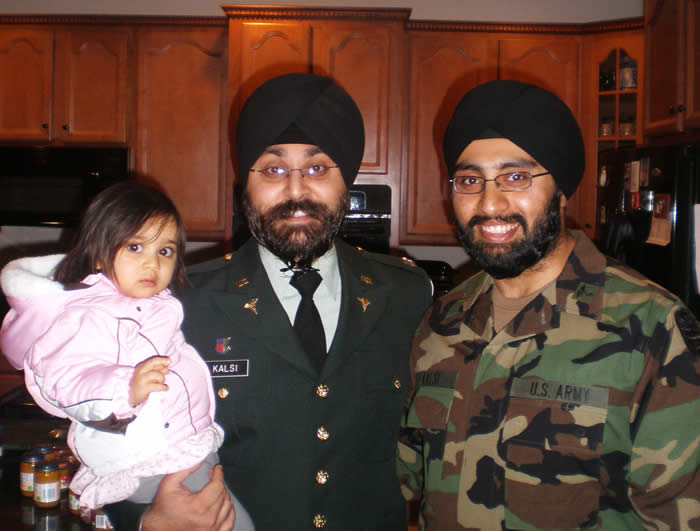
Sikhs Now: Kamaldeep Kalsi (L) and Tejdeep Rattan (R)
Two Sikh recruits in the U.S. Army, Kamaljeet Singh and Tejdeep Singh, were told they would be allowed to continue to wear their turbans as active members of the military. They describe this as being able to wear both their uniforms: that of a Sikh, and of a member of our Armed Forces. Now Army personnel have back-pedaled, claiming a 1981 ban prohibits soldiers from wearing “overt” articles of faith — including the dastar.
Despite a long history of Sikh participation in armed forces worldwide, Steve Levine, a former Army lawyer from 1992-1999, speculates that there are at least two policy reasons for requiring shorn hair: unit cohesion, and the ability to wear military equipment [link]. This seems incongruous given that Sikhs had served on active duty in the Army with full daris and dastars, and were perfectly well-protected, in the past. In light of previous exemptions, lawyers for these Sikhs argue the policy is an undue burden on the free excercise of faith under the Religious Freedom Restoration Act of 1993.
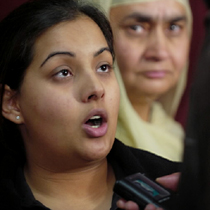
Tajinder (foreground) and Shalinder (background) Bansra.
Shalinder Kaur Basran is one of 19 recipients of the Carnegie Medal for heroism for intervening in a murderous domestic violence altercation in which a husband stabbed his wife. At the time, it was one of three cases in which desi-Canadian women had been killed by their families.
When Bibi Shalinder and her daughter heard a fight escalating downstairs, accompanied with cries for help, they ran downstairs where they found Jatinder Waraich had stabbed his wife, Navreet. She lay bleeding on the floor, crying for help. When he advanced on her, again, Bibi Shalinder forcibly removed him (while he held his knife) from the apartment while her daughter called 911. While police arrested Jatinder, his wife, unfortunately, did not survive his attack.
Reading about this award was really bittersweet for me. On one hand, I think interjecting yourself in the heat of a fight — with someone who’s already been acting crazy and is actively wielding a weapon — requires tremendous courage and strength. On the other hand, the underlying story of domestic violence and murder is heart-breaking. It made me wonder if others would have rushed to assist Navreet Waraich, or if they would have ignored it, assuming it was a domestic disagreement.
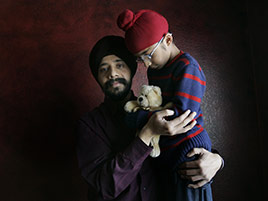 A couple of days ago Darshan Singh took his six-year-old son, Gurjot, to the post office to get a U.S. passport. Unfortunately, his experience is all too familiar: postal workers refused to take Gurjot’s photo, insisting he remove his “hat”:
A couple of days ago Darshan Singh took his six-year-old son, Gurjot, to the post office to get a U.S. passport. Unfortunately, his experience is all too familiar: postal workers refused to take Gurjot’s photo, insisting he remove his “hat”:
A Frisco father says his family’s trip to the post office turned into an emotional experience after a postal worker refused to take his son’s passport picture while the boy was wearing a turban…
“We kept telling them, ‘it’s not a hat,’” Singh said. “I want to make sure that doesn’t happen to any other kid of my religion.”
There was an interesting story recently on Cultural Diversity Day at a local middle school. In addition to featuring dancing, self-defense, and dialogues, a few speakers lectured on their experiences or cultures, including a Sikh speaker:
Wearing a bright blue turban that matched his outfit, Gurparkash Singh, a scientific writer for Bristol-Myers Squibb, told about the Sikh faith. He said it’s easy to identify a Sikh person by looking at the shape of his or her turban. Sikh turbans are triangular and stop at the nape of the neck.
The writers covering the story spoke of the event as going “beyond diversity” and pushing forward what cultural diversity days are all about. It sounds like the event was really well-rounded and incorporated a lot of communities and backgrounds (and probably went far beyond “cultural” diversity to many different concepts of community diversity). I find myself uncomfortable, however, with classifying a religious community as “cultural,” and further, with tokenizing different communities on a single day of diversity awareness instead of incorporating a diversity-framework or lens into an educational or pedagogical model.
I recently came across this CNN report of four individuals who discuss their experiences of wearing religious garments in the US. Two of the individuals are Sikh men (where are the Sikh women at) along with a Muslim woman and a Jewish man.
Ajitpal Singh Rania: Ajitpal lives in the Washington area and immigrated to the United States pre-9/11 into a college town. Aside from curious looks, he feels that he has not really been discriminated against as a Sikh wearing a turban because he arrived in a college town that was more open to diversity. Ajitpal also believes that educational workshops have helped many American learn more about Sikhs. Watch his video report here.
Syeda Martha Graham: Syeda of Kansas City, Missouri, converted to Islam and made a personal decision to not only wear a head scarf but also a face cover. Not wearing her head scarf makes her feel vulnerable, similar to how others feel about not wearing a top. She remembers an incident where a bank employee asked her to take her “mask” off; but another employee came to her defense. Syeda feels more people are nice than offensive. She also wishes people would assume less and ask more questions. Watch her video clip here.
We’ve definitely covered stories on the trials and tribulations Sikhs have faced recently in Texas. I saw this and thought it would be nice to share what students at the University of Texas – Arlington are doing to help dispel ignorance around our faith community.
The line outside the University of Texas at Arlington’s library this week wasn’t for intramural sign-up, a spring break travel package or even hot dogs sold off the grill for a fraternity fundraiser.
The organizers structured the event to trade off gift cards for a promise to wear a turban for a few hours, and during that time, to refrain from smoking, drinking, etc. It was the SSA at Southern Methodist (SMU) that came over and hosted events at neighboring campuses, relying on donations and outreach to the Dallas/Ft. Worth Sikh community.
Turban-tying throughout the week had two purposes: to raise consciousness around Sikhi as a distinct faith, and to expose non-Sikhs to the lived experience of, and discrimination faced by, Sikhs in the U.S.
It only took Keith Jackson two hours to understand the heft of American bias felt by Sikhs. The 31-year-old heavy equipment operator noticed the crowd in front of the library and decided to don a navy turban and an “Ask Me Why I’m Wearing a Turban” button. Then he went to lunch at Subway.
One man asked Jackson’s colleague, who also wore a turban, if he was part of the Taliban. Another man told them that bin Laden was their big brother. Someone on a bike started screaming at them. Everyone stared.
While the coverage in the article is imperfect, I thought it showed an interesting willingness, and engagement, of members of the UTAr campus community to take on a different experience. Overall, though, it sounds like it was effective in opening the door for changing the discourse/reflection on how non-Sikhs interact with their Sikh neighbors.
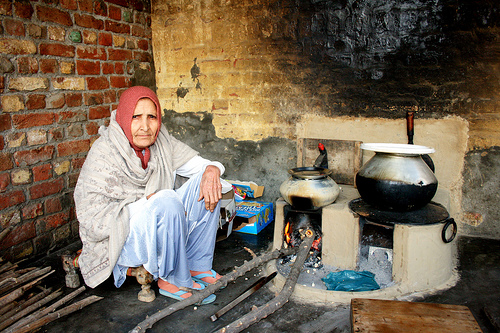
While driving home from a friend’s house one night I noticed something out of the corner of my eye as I passed the rows of darkened homes in his neighborhood. One garage door on the block was open and the garage lights were on, but there were no cars inside. Instead, there was an older Mata/Mai/Bibi/Bebe standing in front of a stove making roti, while a younger lady was dishing out what must have been some dal/sabzi.
The site was kinda cool and I had to resist the urge to stop my car and take a picture to post here – for fear of looking like a creepy weirdo. I did, however, think about it all the way home. What made it worth thinking about for a 10-minute drive is simple: it took me back to Punjab, where many farming families have two kitchens – one inside and one outside (where a bulk of the cooking is done).
